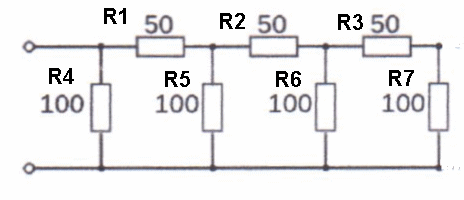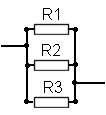|
|
|||||||||||||
|
|
|
||||||||||||
|
|
|||||||||||||
|
Syllabus Sections:- Power 2B1 8 Solve series / parallel resistor circuits to calculate currents, voltages, resistances and power given appropriate values.This may include the use of series/parallel formulae, Ohm's Law and power. Equation include p=V squared / R and P = I squared x R |
|||||||||||||
ResistorsResistors and what they are was introduced to you in the Foundation Licence course and developed in the Intermediate Licence course. There are two quite different and for some of you reading the course challenging formulae associated with resistor combinations whether they are in series or in parallel Resistors in SeriesThe diagram below shows resistors connected in series. For a calculation any number of resistors, (from as few as two) may be connected as shown above. The effective resistance of the combination of R1 R2 and R3 is given by R(total) = R1 + R2 + R3 BUT you can of course add together as many resistors as you need to and calculate the total effective resistance of all the resistors.
Resistors in ParallelThe diagram below shows resistors connected in parallel. Note that all the resistors are linked to each other by the wire that is across the end of of them all so it does not matter where the other wires connect to the circuit the result would be the same. For a calculation any number of resistors, (from as few as two) may also be connected as shown above. The effective resistance of the combination of R1 R2 and R3 is given by which can also be written as :- 1/R(total)= 1/R1 + 1/R2 + 1/R3 BUT as with the earlier example you can of course add together as many resistors as you need to and calculate the total effective resistance of all the resistors. Let's put in some values. R1 = 100 ohms R2 = 150ohms R3 =270ohms Thus 1/R(total) = 1/100 + 1/150 + 1/270 so 1/R(total) = 0.01 + 0.0066 + 0.0037 so 1/R(total) = 0.0203 so R(total) = 1/0.0203 so R(total) = 49.26 So the total resistance of R1, R2 and R3 in parallel is about 49 ohms Note:- that the resulting resistance is always less than the lowest resistor value in the group. However consider what would happen in a mix of series and parallel.. Looking at R3 and R7 they are linked in Series so total value is 150 Ω call that R8 Now look at R2 and R6 they too are link in Series so total value is 150 Ω call that R9 Now looking at R1 and R5 they are linked in Series so total value is 150 Ω call that R10 So now we have  We now have R4 R10 R9 and R8 in parallel So 1 / Rtotal = 1 /100 + 1 /150 + 1/ 150 + 1/ 150 Thus 1 / RTotal = (150+ 100 + 100 +100) / 15000 = 450 / 15000 = 0.03 thus RTotal = 33 Ω For the exam do the calculation as shown and then compare you answer to that in the question and you will see what figure is like yours and pick that as the correct answer. If you are weak on maths then ask your lead instructor for some extra work on this to help you learn it.
|
|||||||||||||
|
|
|||||||||||||
|
|
|||||||||||||
|
|
|||||||||||||













